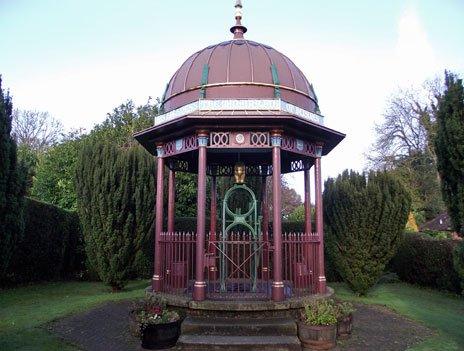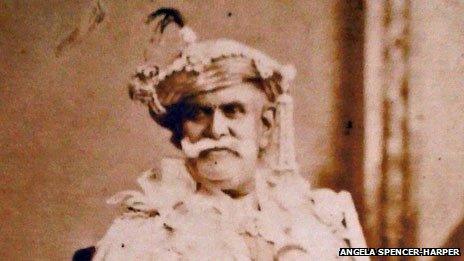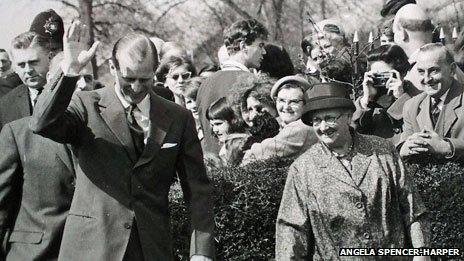The maharajah and the well
- Published

There's been much discussion over British aid to booming India, but in the 19th Century a village in southern England was saved by aid coming the other way.
It was the mid-1800s in southeast England, and a little boy was being beaten by his mother for drinking the last of the water in their house during a drought.
Thousands of miles away in India, the story was narrated by Edward Anderdon Reade, acting governor general of the United Provinces, to the Maharajah of Benares (now Varanasi) at the latter's palace over dinner.
Moved by the story from the Chiltern Hills, the Maharajah agreed to fund the sinking of a well in the village of Stoke Row, still recognisable today by the golden elephant that adorns it.
The construction, known as the Maharajah's Well, was the first of several in the region. All were funded by royals and other benefactors from India, inspired by the Maharajah of Benares's example.

The Maharajah of Benares never visited the well that he financed
"This well is highly unusual because of its funder and history," explains Angela Spencer-Harper, author of Dipping into the Wells.
"At a time when the British Empire was spreading all over the world, this generosity by the maharajah sparked a trend among India's wealthy people to fund wells in the UK. But this one in Stoke Row is the first and will always remain special."
The well's 368ft (112m) depth is equal to St Paul's Cathedral. Two workers dug it by hand, by turns scooping out earth and laying bricks.
Its 4ft diameter proved an extremely tight workplace, and the workers faced danger because of bands of sand between layers of chalk 150ft below the surface, which tended to cave inwards.
"They kept digging, even during the winter. It must have been terrible conditions to work in the dark," says Spencer-Harper. A year later, the digging was done.
Visitors to the Chiltern hills can now see the well's 23ft superstructure topped off by a bright dome. Not content with a simple well, the maharajah also funded the winding machinery and a decorative golden elephant that still stands sentinel.
Officially opened on 24 May 1864, the well cost £353. For comparison, a cottage for the caretaker - built alongside - cost £74 14s 6d.
Some local residents were unimpressed with the expenditure on the grand well.
According to An Illustrated History Of The Maharajah's Well by Laureen D Williamson, the bright colours and and lavish construction upset some who believed the poor community was spending a little too much.
The well served its purpose for 70 years, with the maharajah also financing a four-acre cherry orchard.
The generosity of Reade, born into the Oxfordshire gentry, was being returned. One of his many deeds when he worked for the maharajah in India was to sink a well in 1831 for the local community.
"For the rest of his life, the maharajah continued to pay for the maintenance of the well and also paid to look after the villagers during times of crises," says Spencer-Harper.
"He had a special bond with the people although he never visited the area. I guess people would have given him an imperial reception if he ever came to the village."

The Maharajah's realm of Benares: A long way from the Chilterns
At the maharajah's behest, additions and modifications were inaugurated or commenced on special occasions. A footpath was completed at the maharajah's expense when the Marquis of Lorne married Princess Louise in 1871.
In 1882, when Queen Victoria survived an assassination attempt, he funded a ration of free bread, tea or sugar, as well as lunch for the villagers.
Reade's death in 1886 started the decline of the well, and the arrival of a reliable pipeline in 1927 sealed its fate. Use declined and it fell into disrepair.
In 1961, the then Maharajah of Benares mentioned the forthcoming centenary of the well to Queen Elizabeth on her visit to the Indian city.
Nearly 1,500 people attended the celebrations in Stoke Row on 8 April 1964, with Prince Philip among them.

The Duke of Edinburgh marks the well's centenary in 1964
The relationship with India was commemorated with water from the holy river Ganges being ceremonially poured into the well.
"The well certainly changed the way people lived in the area," says Spencer-Harper. "The area and village of Stoke Row had no natural water resource and people would drink from puddles, causing them diseases.
"Many new houses were built around the well and people got more work. Even a brick factory was started after the well."
And those with an interest in the history of the well are already looking forward to the 150th anniversary in 2014.
You can follow the Magazine on Twitter , externaland on Facebook, external.
BBC Monitoring, external reports and analyses news from TV, radio, web and print media around the world. For more reports from BBC Monitoring, click here. You can follow BBC Monitoring on Twitter, external and Facebook, external.